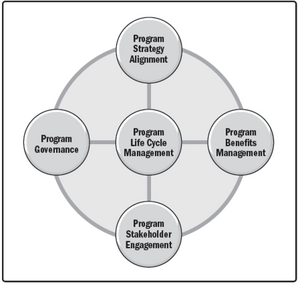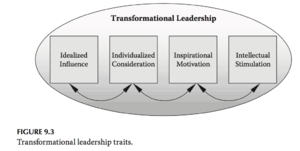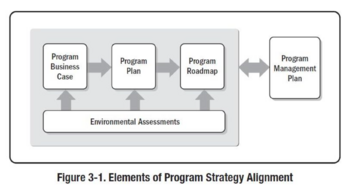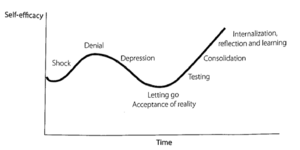The Oticon Case: the Spaghetti organisation
(→Type of leadership) |
(→Solution) |
||
| Line 37: | Line 37: | ||
==Strategy Alignment== | ==Strategy Alignment== | ||
| − | + | [[File:StratergyAlignment.png|350px | thumb| |'''Figure 3:''' Program strategy alignment ]] | |
The radical change that Oticon underwent resulted in a several number of projects. Some of those had very different nature and where not interrelated at all. Hence, a perfect alignment of all of them was imperative for not making a complicated program out of a complex one [Ref article class]. In order to manage the strategy alignment of the different projects and processes, the program manager should address three different elements: the program business case, the program plan and the program roadmap and the environmental assessment. [Ref wiki change] Among those aspects, the ones strongly related with leadership are the program plan. | The radical change that Oticon underwent resulted in a several number of projects. Some of those had very different nature and where not interrelated at all. Hence, a perfect alignment of all of them was imperative for not making a complicated program out of a complex one [Ref article class]. In order to manage the strategy alignment of the different projects and processes, the program manager should address three different elements: the program business case, the program plan and the program roadmap and the environmental assessment. [Ref wiki change] Among those aspects, the ones strongly related with leadership are the program plan. | ||
The program plan aims to clarify the organisation concept, vision, mission and benefits produced by the program [ref wiki change or book] This task was exceptionally performed by Lars Kolind, who was able to define a clear vision, under the motto "Think the unthinkable", as well as a clear a mission: "help people (with impaired hearing) to live as they wish with the hearing they have". By clearly defining those two concepts and efficiently communicate them to all the stakeholders, he created a strong shared sense of direction and gave sense to the program [Book management of change]. It should also be pointed out that he also clarify the benefits of his program to the different stakeholders. For instance, when the program was launched, he send a newsletter to all the employees of the company explaining why the company needed that change and which benefits the program will produce. Some days after, a meeting with all the employees took place. It aimed to clarify all the possible doubts they could have. Anyone was obliged to go, but almost everyone went. | The program plan aims to clarify the organisation concept, vision, mission and benefits produced by the program [ref wiki change or book] This task was exceptionally performed by Lars Kolind, who was able to define a clear vision, under the motto "Think the unthinkable", as well as a clear a mission: "help people (with impaired hearing) to live as they wish with the hearing they have". By clearly defining those two concepts and efficiently communicate them to all the stakeholders, he created a strong shared sense of direction and gave sense to the program [Book management of change]. It should also be pointed out that he also clarify the benefits of his program to the different stakeholders. For instance, when the program was launched, he send a newsletter to all the employees of the company explaining why the company needed that change and which benefits the program will produce. Some days after, a meeting with all the employees took place. It aimed to clarify all the possible doubts they could have. Anyone was obliged to go, but almost everyone went. | ||
| − | |||
| − | |||
| − | |||
| − | |||
| − | |||
| − | |||
==Stakeholder management== | ==Stakeholder management== | ||
Revision as of 22:39, 21 September 2015
The Spaghetti organisation was the result of a radical change that undergo the danish hearing manufacturer Oticon. When in 1988 Lars Kolind took over as the CEO, the market share of the company had dropped dramatically. That situation called for a revolution in the company in order to remain competitive. Back then, the company was up against big companies like Siemens, Philips, Sony, M3 and AT&T. It was impossible to compete against them on financial resources, technology or marketing. The only way to remain competitive was to create something that the big companies would never be able to replicate: an innovative fast-moving organisation.
As a result of the radical nature of the change, the necessary program to make it happen was extremely complex. The new organisation aimed to modify all the interactions between the different parts of the company, and, consequently, the behaviours produced as a result of those interactions.Therefore, it was crucial a strong leadership in order to create clear directions and ensure effective communication to speed up the "sense-making process". This article aims to analyse the leadership of Lars Kolind in order to highlight which points lead to the successful implementation of the change.
In order to approach the case from a program management point of view, it is necessary to see which domains of that discipline are related with leadership. As it can be seen in Figure 1, the different domains of a project management performance are basically four: the Program Strategy Alignment, the Program Benefits Management, the Program Stakeholder Engagement, the Program Governance, and the Program Stakeholder Engagement. Among those, the ones related with leadership are the Program Strategy Alignment and the Program Stakeholder Engagement. Throughout this article those two domains are analysed in the case at hand.
Contents |
Context
Once Lars Kolind was appointed CEO of Oticon, a period of rationalisation and cost-cutting started. During his first years as CEO, Kolind undergo a diagnosis of the company by meeting with clients and managers, analysing all the different parts of the company and understanding the market where they where competing. Then, in 1990 he announced a broad package of innovative and radical measures in the job design, the organisational structure, the physical layout of the company and the way of sharing information. Some of those changes included:
1. Go from a hierarchical organisation to a project-oriented one. In that organisation, every employee was involved in more than one project at the same time. Those projects were usually cross-functional and cross-organisational and were considered as "business units", with their own resources, time, schedule and success criteria.
2. Change from a rule-based, departmentalised hierarchical engineering culture to a customer-focused, flexible, innovative business culture.
3. All current job titles disappeared. The managerial authority was transferred to the project groups or the individual employees. There were no more managers, only project leaders that were chosen by the members of the group. Moreover, there was the figure of the mentor. Those ones were responsible to coach and support a number of staff members. These members had to voluntarily choose them as their mentor.
3. Oticon became a paperless organisation. Computers were introduced in the every day life of the company. All incoming mails were scanned and new systems to share the information were created. It has to be said that by then, people didn't know how to use computers.
4. The office became an open space office. Every worker had a trolley that can use to move easily from one project to another. The organisation moved the headquarters to a new building that fulfilled the requirements of the new working space.
5. Complety change the hearing aids. First, switching from Behind The Ear (BTE) hearing aids to Inside The Ear (ITE) hearing aids. Second, using digital processors instead of analog processors.
The challenge
A big change started and the structureless organisation was in the edge of the chaos. The limited resources of the company challenged the planning of its CEO. First, the financial situation of the company constrained the room for manoeuvre of Kolind. Second, the employees were not ready for some of the new processes that the new company required. For instance, a paperless organisation required a staff with advanced computer skills. However, during the 90s, the computers were a new technology in the market and not everyone knew how to use them. Another example is the fact of eliminating all the job titles. Some managers didn't find their place in the new organisation. That challenged the program as well, as it was difficult to have the right people in the right position. The only way to deal with that chaos was a strong leadership.
Solution
Type of leadership
Managing is about "doing things right" and leadership is about "doing the right things" (Bennis and Nanus, 1985, p. 21). One of the reasons for why Lars Kolind did the right things was because of the type of leadership he embraced. Hence, before analysing the different aspects of the program management, it is necessary to understand how Lars Kolind approached the situation while being the CEO of Oticon. That way, it will be easier to understand one of the key factors of the success of the program. According, to Marc C. Bojeun, it exist different types of leadership within the program management. One of the most important are the transactional and transformational types. On the one hand, the transactional leadership focuses on the role of supervision, organisation and group performance. This type of leadership is based on the assumption that the only motivation of the worker is his own gain. Therefore, in order to improve the performance of the group is necessary some extrinsic motivation as additional salary, time off when the program is completed, potential promotion, not loose one's job, etc. On the other hand, the transformational leadership is based on a more charismatic, inspirational and intellectual leader. A leader who uses this approach intrinsically motivates and empower his employees by creating a common vision, a common goal. Any leader is neither 100 percent transactional nor transformational. Nevertheless, it can be argued that Lars Kolind was mostly transformational. The new organisation that he promoted strongly relied on the empowerment of the employees and the intrinsic motivation of those. The individuals were informed enough to understand their role in the organisation and the teams were driven by objectives. Therefore, Kolind strongly believed in the Theory Y, counting on the positive nature of people. However, it has to be say that he also applied supervision of the employees. For instance, once a year, all the employees had a meeting with their mentors to discuss their performance during the year and readjust their salaries accordingly. It should be also pointed out that the fact of creating a strong culture around the new organisation made less necessary to apply command and control techniques [book findit]
Strategy Alignment
The radical change that Oticon underwent resulted in a several number of projects. Some of those had very different nature and where not interrelated at all. Hence, a perfect alignment of all of them was imperative for not making a complicated program out of a complex one [Ref article class]. In order to manage the strategy alignment of the different projects and processes, the program manager should address three different elements: the program business case, the program plan and the program roadmap and the environmental assessment. [Ref wiki change] Among those aspects, the ones strongly related with leadership are the program plan. The program plan aims to clarify the organisation concept, vision, mission and benefits produced by the program [ref wiki change or book] This task was exceptionally performed by Lars Kolind, who was able to define a clear vision, under the motto "Think the unthinkable", as well as a clear a mission: "help people (with impaired hearing) to live as they wish with the hearing they have". By clearly defining those two concepts and efficiently communicate them to all the stakeholders, he created a strong shared sense of direction and gave sense to the program [Book management of change]. It should also be pointed out that he also clarify the benefits of his program to the different stakeholders. For instance, when the program was launched, he send a newsletter to all the employees of the company explaining why the company needed that change and which benefits the program will produce. Some days after, a meeting with all the employees took place. It aimed to clarify all the possible doubts they could have. Anyone was obliged to go, but almost everyone went.
Stakeholder management
Stakeholder management is an important factor to take into account in every organisational change. It is necessary to identify which stakeholders will be affected and evaluate what's their degree of commitment. To facilitate the change process, the program manager must communicate a clear vision of the need of change to all the individuals affected. He must have strong leadership skills in order to set clear goals, see when is necessary the change, plan the change, monitor the change and manage the people issues along the change [. As it can be seen in Figure 4, the Stakeholder management can be divided in four steps: planning, identifying, engaging and management of expectations.One of the key factors of the success of the change process of Oticon was that Kolind followed those steps.
Identify Program Stakeholders
During his first years as CEO, he met several clients in order to understand their concerns and what was their idea of Oticon. Moreover, he met with internal stakeholders as managers and employees of different departments. He asked them what they thought was the vision of the company and why they think the company was in such trouble. He also figured out which ones where the relations between the different departments and what was each department exactly doing. The identification of stakeholders was done.
Engage Program Stakeholders
Then, it was necessary to plan how engage and manage the different individuals involved. At that point, the most critical point was to create a clear shared vision with all the stakeholders. Until then, the vision of the company was "leaders in hearing technology". When the change started, the vision became "helping people (with impaired hearing) to live as they wish with the hearing they have". This motto and putting the new focus on the hearing care profesional instead of the end user created a clear and common vision.
Apart from the vision, another aspect to take into account while dealing with the stakeholders engagement is the communication. Within a company, several channels are used, but only one message is wanted to be transmitted. That's why is important to plan the how to transmit the message. The strategy used by Kolind was to send a newsletter titled "Think the Unthinkable" explaining all the different changes he wanted to perform. Some days after, a meeting with all the employees took place. It aimed to clarify all the possible doubts they have. Anyone was obliged to go, but almost everyone went. He explained the idea and, in order to involve the employees in the process, he let them vote who wanted to be part of the project. Most of the audience respond positively. They were engaged in the change process. This commitment was crucial in further situations. For instance, due to the lack of financial resources, the company give the option to the employees to invest money in the company. The first who invested was Lars Kolind, fact that increased even more the commitment among the other employees. This strategy was embraced by Kolind other times as well. For example, as any employee of the company had an office, he didn't have neither.
Not only the internal stakeholder where addressed. Kolind also took care of asking the clients which where they concerns and what they were looking for in a product. Those inputs were really important to decide the vision of the company and choose the new projects to develop, while they engaged the clients in the change process.
Manage stakeholders expectations
Another important aspect when managing the stakeholders is to take into account which expectations they have. If a program negatively affects a stakeholder, it is necessary to mitigate the impact in order to maintain the stakeholders involved. It is important to make sure that stakeholders expectations are based on accurate information. Therefore, once more, it is important an effective communication.
In the present case, one of the biggest problems of the new organisation was to remove all the job titles. This fact created two major problems within the company.First, the resistance of the senior and middle managers.. Their expectations of loosing their benefits and power in the new organisation put them against the process. Frequently, during a change process, the stakeholders who doesn't support the change used to go through eight different stages : Shock, Anger, Denial, Depression, Acceptance of reality, Testing, consolidation and Internalisation (see Figure 4). Therefore, the task of the program manager is to contain the denial phase (e.g. not negatively affect the other stakeholders) and emotionally support the stakeholders during the depression part. Lars Kolind said: “One day a former middle manager came to me to discuss (…) he openly admitted that he didn’t know what to do for the company.” (oticon case). At that point, the former middle manager was entering in the depression phase. The duty of a good leader was to support him emotionally. Kolind made him see that he was not only a manager,but also once was a great specialist. That, made the middle manager decide to return to the specialist role: “He admitted that when he had been promoted to department head, the company had lost a good specialist, and gotten a bad leader in return”[ref oticon case]. In that example, we can see how Kolind was able to influence the middle manager, affecting his beliefs and attitude towards the organisation. Apart from the resistance of the middle managers, another problem arose. Some people felt frustrated because it was not possible to get promoted in the organisation. The fact of not having job titles make impossible to get promoted. The salary was fixed according to the contribution of each individual to the organisation by participating in successful projects. That extreme competitiveness made some employees not to feel comfortable. Even thought there was not a formal hierarchy, a “natural hierarchy” was created as some projects were more successful than other and some groups more productive. In that case, Kolind couldn’t do anything, as this problem was a collateral effect of the same nature of the organisation.
Implication
We can learn the importance of a good leadership and how to learn while doing the program.
of a complex one [Reference article class]. This was the task of Lars Kolind, the one in charge of creating a shared sense of direction and giving sense to the program [Book management of change]. As the program manager, Lars Kolind was responsible of creating a clear vision of the need of change and effectively communicated to all the different stakeholders.
The program manager must utilize strong leadership skills to set clear goals, assess readiness for change, plan for the change, provide resources/support, monitor the change, obtain and evaluate feedback from those affected by the change, and manage issues with people who are not fully embracing the change.
As the CEO of the company, Lars Kolind was responsible of the long-term vision of the company. This long-term
had to deal with several projects that formed the program of the change of the company. As a program manager, he was responsible for a long-term vision that required an alignment of all the different projects. This requires a previous strategy



